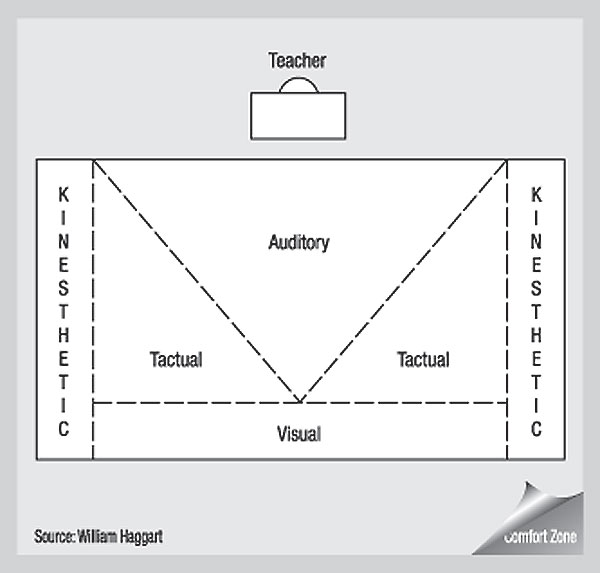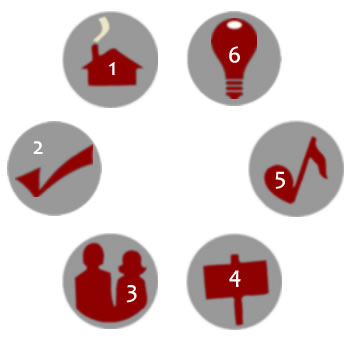 Function I: Security and Shelter
Function I: Security and Shelter
Classroom Setting Strategies Nos. 1 through 7
- Physical Security
- Psychological Security
- No. 3: Add elements of softness to your classroom.
- No. 4: Arrange students' seats according to their learning style preferences.
- No. 5: Arrange the room so students are free from interference, intrusions, and distractions.
- No. 6: Provide students with one or more places for privacy.
- No. 7: Provide students with places to store personal belongings.
Physical Security
Classroom Setting Strategy No. 1: Know how to respond to emergencies.
- Be prepared for whatever emergencies may arise.
- Keep a first-aid kit in your classroom.
- Have a readily available list of parents, doctors, and emergency phone numbers.
- Know where the nearest phone is.
- Keep cleaning supplies stocked in preparation for spills, broken glass, and other accidents.
- Know how to contact the maintenance personnel.
- Know the location of the closest fire extinguisher.
- Practice safety drills for emergencies such as fires, floods, earthquakes, tornadoes or hurricanes.
Classroom Setting Strategy No. 2: Eliminate hazards, and safely handle supplies.
Repair or remove items that may cause accidents, such as faulty light fixtures, loose wall shelves, or impediments to the flow of traffic. Find out your school's policy for ordering, using, and storing all supplies, especially potentially dangerous materials. Teach students know how to correctly handle common items such as scissors, glue, and paint.
Psychological Security
Classroom Setting Strategy No. 3: Add elements of softness to your classroom.
Schools are traditionally places with a lot of hard surfaces. Create softness in your classroom through the use of carpeting, cushions, furniture, and decorations. Increasing students' comfort level has a positive effect on student participation in class; in one study, the average number of students' comments doubled once elements of softness were added to the classroom (Cooper & Simonds, 2003).
Classroom Setting Strategy No. 4: Arrange students' seats according to their learning style preferences.
Matching students' natural learning style preferences with where they are seated in the classroom can contribute to students’ feelings of comfort and security.
- Kinesthetic: Kinesthetic students need to move. Seat them where they can move without disturbing others.
- Tactual: Tactual students need to "keep tabs" on their environment. They are most comfortable in a central area where they can see (and feel) the whole classroom.
- Auditory: Auditory students need to be up front and in the midst of classroom conversation. They are most comfortable where they can hear and be heard easily.
- Visual: Visual students want to be able to see everything. Giving them a large personal space in the back of the room will add to their comfort.
Below is a view of students' comfort zones based on their learning styles.

Classroom Setting Strategy No. 5: Arrange the room so students are free from interference, intrusions, and distractions.
Remove any physical or visual distractions — this strategy is especially important for students who can become easily distracted. Make sure there is enough space around students to allow them to move about easily without bumping one another.
According to Fred Jones, "The objective of room arrangement is to create walkways" (2000, p. 32). Jones believes teachers must be able to stand at the front of the room and get to all students easily to supervise their work. He recommends teachers make compact room arrangements that contain two broad aisles, which he calls "boulevards." The most important feature of room arrangement is not where the furniture goes, but, rather, where the furniture does not go.
Source: Jones, Fredric H. Ph.D. Fred Jones Tools for Teaching: Discipline, Instruction, Motivation, 2000.
Classroom Setting Strategy No. 6: Provide students with one or more places for privacy.
Students often spend hours a day with large groups of their peers. For many, so much time in a group can be stressful and over stimulating. Providing students with a private space where they can be alone gives them an opportunity to regain their emotional balance and mental focus.
You may designate this private space as a place for a "positive time-out." Students may choose to go to the private space without providing an explanation to their teacher, and once students are in the private space, no other students may interact with them. Taking a positive time-out is strictly voluntary — it is not a punishment and students may not be sent to the positive time-out spot.
This strategy promotes responsibility because it encourages students to take ownership of their feelings and choose appropriate action by taking a time-out when they need one. If you're concerned about students taking advantage of the time-out space to avoid working, you may want to set a limit on how many time-outs a student can take in a week or a day, and how long each time-out can last.
The private space doesn’t need to be visually cut off from the rest of the room, nor does it need to involve a lot of work or complicated classroom redesign. Involve students in the process of creating their positive time-out space. They can help in selecting a theme, choosing a name, and designing decorations.
Examples:
- The Rain Forest — Set up a comfy chair in front of a student-made mural of a rain forest. Hang plants, such as ferns and philodendrons, to create a jungle effect. Provide some of stuffed animals for holding and a Walkman so students can listen to rain forest sounds or soothing music.
- A Beach Break — Lay out a large beach blanket, set out a lounge chair and an umbrella, and put up posters of the ocean. Display interesting shells next to a shell identification book. Place a sand tray with a small rake and a container of rocks next to it. Students can create their own designs and arrangements.
- Australia — Educational consultant Susan Kovalik (2002) suggests creating "Australia," based on the book Alexander and the Terrible, Horrible, No Good, Very Bad Day, by Judith Viorst. In summary, Alexander wakes up one morning and everything starts going wrong — both at home and at school, He has one disappointment after another. Alexander decides that the best way for him to handle his problems is to go to Australia. A momentary trip to "Australia" in the classroom may give students the break they need from the pressures they feel.
- The Quiet Corner — Create a cozy nook equipped with a rocking chair or large pillows, a small blanket, and a good reading lamp. The corner may be partially screened from view by a bookshelf containing interesting fiction and nonfiction books, coffee-table books with dynamic photographs, and magazines. Puzzles and manipulatives may also be supplied.
Classroom Setting Strategy No. 7: Provide students with places to store personal belongings.
Elementary students often have desks and cubbies for their personal items; however, it can be challenging to provide personal space for high school students who change classes each period. Individual hooks, plastic storage bins, and reserved space on a bookshelf may be used for backpacks and other personal items.
Strategies by Function
Click the images or text links below to navigate to the rest of the strategies

